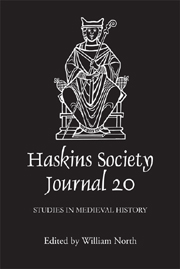Book contents
- Frontmatter
- Contents
- Editor's Note
- Abbreviations
- 1 Buckets, Monasteries, and Crannógs: Material Culture and the Rewriting of Early Medieval British History
- 2 Punishing Bodies and Saving Souls: Capital and Corporal Punishment in Late Anglo-Saxon England
- 3 Writing Latin History for a Lay Audience c. 1000: Dudo of Saint Quentin at the Norman Court
- 4 Between Neighbors and Saints: Waleran I of Meulan and the Allegiance of Lesser Lords in the Eleventh Century
- 5 Who Founded Durtal? Reconsidering the Evidence
- 6 Robert Curthose: Ineffectual Duke or Victim of Spin
- 7 The Chivalric Transformation and the Origins of Tournament as seen through Norman Chroniclers
- 8 An Internal Frontier? The Relationship between Mainland Southern Italy and Sicily in the ‘Norman’ Kingdom
- 9 ‘Hywel in the World’
- 10 Prices, Price Controls, and Market Forces in England under Edward I c. 1294–1307
3 - Writing Latin History for a Lay Audience c. 1000: Dudo of Saint Quentin at the Norman Court
Published online by Cambridge University Press: 12 September 2012
- Frontmatter
- Contents
- Editor's Note
- Abbreviations
- 1 Buckets, Monasteries, and Crannógs: Material Culture and the Rewriting of Early Medieval British History
- 2 Punishing Bodies and Saving Souls: Capital and Corporal Punishment in Late Anglo-Saxon England
- 3 Writing Latin History for a Lay Audience c. 1000: Dudo of Saint Quentin at the Norman Court
- 4 Between Neighbors and Saints: Waleran I of Meulan and the Allegiance of Lesser Lords in the Eleventh Century
- 5 Who Founded Durtal? Reconsidering the Evidence
- 6 Robert Curthose: Ineffectual Duke or Victim of Spin
- 7 The Chivalric Transformation and the Origins of Tournament as seen through Norman Chroniclers
- 8 An Internal Frontier? The Relationship between Mainland Southern Italy and Sicily in the ‘Norman’ Kingdom
- 9 ‘Hywel in the World’
- 10 Prices, Price Controls, and Market Forces in England under Edward I c. 1294–1307
Summary
Early in the 990s, the Norman ruler Richard I (d. 996) convinced Dudo, a canon of Saint Quentin, to write a history of the Norse who had settled in the western part of the French kingdom. Much history, of course, had been written during the previous two centuries that treated the activities of the Vikings and their posterity. The stories that related the invasions of the regnum Francorum from Scandinavia, the Norse settlement in Rouen and in the other civitates of Lugdunensis secunda were well known, as were the military activities of others of their Viking brethren. This history, however, had been produced at places such as Saint Bertin, Fulda, Prüm, and Reims, and the authors of these works portrayed the Norse in an exceptionally negative light. Indeed, a common epithet for them was pirates. It was time, Richard concluded, for the Northmen to have their story told in the way he wanted, a new story that would bring both glory and honor to his people.
Focus on the activities of a particular gens, whatever other motives might have been at issue for both patrons and authors, was hardly a new idea. As the first millennium of the Christian era was drawing to a close, this historical genre appears once again to have been gaining in popularity. For example, Widukind of Corvey had completed his Rerum Gestarum Saxonicarum a decade or more before Richard made contact with Dudo.
- Type
- Chapter
- Information
- The Haskins Society Journal 202008 - Studies in Medieval History, pp. 58 - 77Publisher: Boydell & BrewerPrint publication year: 2009



